Rotating is a huge piece of the golf swing, but most people don't understand how to do it correctly.

"Namaste" position
This golf lesson will teach you how to rotate correctly in the golf swing and understand the movement of the arms or - more to the point - their lack of movement.
These five simple golf rotation drills will help you learn to rotate properly, groove rotation, and get your arms under control and in sync with your body.
Start out by standing up straight. We never begin by doing drills in golf posture, or with the golf club. Instead, we boil everything down to the simplest, most basic movements. This gives your brain the chance to understand and pay attention to each of the different movements that, together, make up the golf swing.
Even something as simple as the shoulder rotation involves a lot of different muscles working together. You need to develop kinesthetic awareness of exactly what you're trying to do, and feel it throughout the whole rotation, in the backswing and the downswing.
Step One - Just the Obliques
To begin with, we're going to focus on the backswing. We'll look at how the shoulders rotate as they go back.
Stand up straight and set your feet just slightly outside of neutral joint alignment. Start out with your hands in the same position we used when getting into our setup posture. Place your hands together vertically, directly in front of your chest as if you were getting ready to bow to someone. We sometimes refer to this as the "Namaste" position.

Engage the obliques to perform proper upper body golf rotation
Now you're going to turn your upper body without moving your hips. You will start to feel your oblique muscles (see diagram), which are designed to rotate your torso and your hips.
Turn very slowly at first and concentrate on learning what it feels like to use your obliques.
The obliques are your first checkpoint. If you've already spent some time working on the takeaway and the right shoulder blade glide, you may feel that going on as well. That's great; it will help pull all that rotation in toward your spine. Just rotate around your spine in each direction, leaving your hips quiet.
Keep Those Hips Still for Proper Golf Rotation
The reason you have your hands in front of your chest is to allow you to feel and see whether or not your hips are rotating along with your torso. The goal is to keep your hips very quiet, not allowing them to follow along with the rotation in the golf swing.
You may feel as though your hips are completely still, but be sure to check yourself in a mirror, because many golfers will find that their hips aren't staying as quiet as they think. If your hips are moving all over the place in the golf swing, you'll have a loss of control.
Until you're able to do this simple drill, rotating your torso without turning your hips, there's no way you're ever going to do it in the golf swing.
You're obviously not trying to make a 90-degree shoulder turn at this point. Without getting your hips involved, you'll probably be getting about 45 degrees of turn.
Work on this drill until you can keep your hips still, and can feel your obliques and maybe that right shoulder blade working in toward the spine a little bit.
Now Check Your Hands
Once you're comfortable with the first part of the drill, the next step is to check your lead hand. If you're a right-handed golfer, that's your left hand.

Are you pushing with your left hand?
As you work on your golf rotation, look to see if your left hand is starting to push your right away from the center of your chest. It may be very, very subtle at first; you may not even notice as your left shoulder tenses up and you put increased pressure on your right hand, but probably 9 out of 10 golfers we work with at the Academy do exactly that.
That's why we take all these drills down to the bare minimum; so you can start to feel when things going wrong, even if it's very subtle at first. Right now you should just be feeling your obliques, and maybe the right shoulder blade. Your hips are staying quiet.
If you feel your hands pushing across, or if you look in the mirror from down the line and your hands have moved off the center of your chest, then you're pushing with that left side.
This is why so many golfers can't get their backs to the target. When we look at the full swing, many golfers say, "Oh, I've never gotten my back to the target. I've never made a full shoulder turn. I'm not flexible enough."
It's Not About Flexibility
In all the years we've taught golf, there has never once been a student who was actually incapable of getting their back to the target. It has nothing to do with flexibility. It has to do with moving from the right spots.
Obviously, teaching golf in Florida we work with many older golfers who do have very limited flexibility.

Shoulder rotation, as seen from above
If you pull your right shoulder back behind your head, the movement required to make a full shoulder turn is tiny. You're only moving your shoulder about six inches; anybody can do that. Everybody has enough flexibility to pull their right shoulder behind their head.
However, if you're pushing from the left, it's very difficult to make a full shoulder turn. You therefore want to be very aware of your movements, to make sure you're not pushing with that left hand. Your left hand should be nice and relaxed, allowing your obliques and the right shoulder blade to do the work of rotating your torso.
Spend a Few Minutes on Golf Rotation
Some people may get this right away, but we strongly recommend that everyone spend at least 5 or 10 minutes just drilling Step One and doing simple rotations.
Don't get into your posture, don't move your arms. Just stand up straight and rotate around your spine so you become truly aware of your obliques. These are the muscles that actually transport the club back during the backswing.
Step Two - Add in the Arms

Let your torso transport your arms
Once you've mastered the first stage - when you're no longer pushing from the left and you can feel both obliques rotating your torso, and maybe feel that shoulder blade moving in - then it's time to add the arms back into the mix.
Standing in the same upright posture, lift your arms about 45 degrees away from you, to approximately belt-buckle height. Hold your hands about an inch apart and repeat the drill, the same as before.
Use your torso to rotate back, keeping your hands in front of your body just as you did when they were up in front of your chest.
Once again, you're going to check for push. If you rotate to the right and find that your hands are ahead of your chest, you'll know that you're pushing with that left arm.
Just as you did above, check for tension in your left shoulder. You may find that your left side starts to tense up - the shoulder and chest muscles - as you begin to push across your body.

Don't let your hands get ahead of your chest
You obviously don't want that, because pushing inhibits your shoulder turn.
If you're having trouble with push, try imagining that you're leaving your hands right where they are at address, and just concentrate on turning your torso. Picture leaving your hands behind entirely, not moving them at all.
If you picture yourself leaving your arms behind and just focus on using your obliques and that right shoulder blade glide to rotate, you lose that tension in your left shoulder. Once you let go of the impulse to push, you can keep your hands intact and make a good rotation.
Perform the rotation, slowly at first, using your obliques to turn in each direction. As you rotate left, you may notice yourself starting to push from the right, activating your right shoulder just as you did the left. Again, you want to keep both shoulders very relaxed.
Watch your hands. Make sure they stay one inch apart as you use your obliques to rotate your torso.
Do it very, very slowly at first. Your brain does not work at full speed right off the bat; we know this by now. It takes time to groove the new movement patterns. You want to do this drill 20-30, even 40 times the first time you do it.
Step Three - Setup Posture
Once you've got the simple rotation down and you've added your arms back in without pushing from the left, the third step is to put your hands back into the "Namaste" position and do the drill in your golf posture.

Repeat the drill in setup posture
If you've already gone through the setup lessons you know how to hinge from the hips and get in the box for your setup posture.
Put your hands back in front of your chest like you did for Step One and once again use your obliques to rotate back, then through. As before, there is no hip rotation at this point.
As you rotate, you will notice that your muscles feel a little different as they engage. When you hinge from the hips, you're putting your muscles into a different position. They're going flex and move differently, which will affect the feel of the rotation.
That's why we start this drill standing up straight, and without the club. At first you're just learning what it feels like to engage the obliques, checking to see if you're pushing from the left, and making sure your hips stay still.
Many golfers do just fine with Steps One and Two, then go right back to turning the hips and pushing with the arms as soon as they get into the setup posture.
The brain shifts from "drill" mode to "golf swing" mode, and you're right back to your habitual movement patterns. You're going to combat that by focusing on staying nice and relaxed. Keep your arms and hands relaxed, with no tension in your left shoulder.
As you rotate back to the left, keep your right side completely relaxed, using just the obliques to make the movement. You can go ahead and use the right shoulder blade glide a little bit on the backswing.
Practice this until you're confident that you're not pushing from the left side, you're not engaging the left shoulder, and you're not turning your hips.
Step Four - Bring Back the Arms
Once you master that, you're ready for the fourth step which is to repeat the drill in posture, in the box, and with your arms down in setup position. Place your hands one inch apart and do the exact same thing as before.

Leave your hands at address
As always, keep your arms still. If you're still feeling that you can't stop pushing from the left on the previous drills, don't even bother with this one. Go back to the earlier steps and work your way up to this once the others have become second nature.
When you're ready for this step, get into your setup position and place your hands one inch apart. Really take your time, feel your obliques, and again try to leave your hands at address. Right away, if you feel any tension in this step, return to address, relax that shoulder, and start again.
If your shoulders start tensing up, shrug them up to your ears and then pull them down to relax them and get back in the box. Relax your arms again, and focus back in on your obliques.
As always, rotate back nice and slow. Imagine that you're leaving your hands back at setup, keep your hips still, and rotate through.
Don't worry about weight transfer at this point. That's an advanced step that we'll add later. For now, just focus on the core golf rotation movements.
Forget About Golf
Get into setup position and do the shoulder blade movement and torso rotation.
Forget about golf for a few minutes, and just concentrate on learning the new movement patterns. Keep your hands one inch apart, leave your arms at address, use your obliques and your shoulder blade to rotate, and simply allow your arms to be transported along with your torso.
This is the most advanced step yet, and it's going to take some practice. Each step builds on the one before; we you start with the simplest movement possible, then add each element in, one at a time.
Finally, Step Five
The final step is, of course, to pick the golf club back up. This is where things get really tricky, because as soon as you get that club back in your hands, your brain goes straight back to "golf swing" mode and if you're not careful all the new movement patterns can get thrown right out the door.
Take your time. Don't rush straight back to actually hitting a golf ball and swinging a golf club at full speed because, as we all know, as soon as you put that little white ball in front of you, your brain is going to want to go straight back to the old patterns and forget all the things you've been working on.
That's why you need to drill this over and over, and that's what the workout program at the end of this lesson will give you. Do your reps day after day, and in a few weeks you'll start to really understand and feel the movements. You won't know any other way to move.

Add the club back in
That's the goal, to get you to move correctly and build these motions into your movement patterns so they become second nature.
So let's give it a try. Get into your setup position again, and this time pick up a golf club. You're going to do the exact same movement. Don't swing your arms. Just rotate back, trying to leave your arms at address.
Focus on feeling your obliques, just as you did at the very beginning. Don't change anything. Even though you've got a golf club in your hand, your mental focus is up on your shoulder blade, and on keeping your hands and arms relaxed.
If you notice any tension, or you start grabbing the club tighter in your left hand, go back immediately to address and relax your hands. You may need to hold the club very lightly at first in order to be able to do this.
That's the Secret
As you begin to rotate, you should feel that the club is simply being transported back. It is moving solely because of the work you're doing with your obliques and your shoulder blade, nothing else. You're not moving it with your hands, you're not moving your arms, you're not moving from your shoulders.
That's the key. That's the secret behind making a centered rotation, making a full turn, and keeping the club perfectly in sync with the body.
Once you are able to rotate back to the right correctly, you can go ahead and add some rotation through, to the left.
Your hands are just following along. They're always in the center of your body. If they start to move away and the club is no longer pointing at the center of your body, go right back to the beginning, relax, and start again.
This is the key drill. Master each step in turn, until you're ready to add the club back in. Once you've mastered Step Five, you're ready to start hitting golf balls again.
This drill is a prerequisite to the 9 to 3 Drill, where you're actually hitting balls out on the range. You need to work this drill a lot before you go out and start hitting golf balls.
Take the time to focus on this drill and improve your body rotation and arm movement. If you master these five steps, your golf swing will improve dramatically.
Daily Drill - 5 Minutes to Mastering Golf Rotation
Start out with 25 reps of each variation. As you become proficient, you can remove steps 1-3 and add 35 reps each to steps 4 and 5.
- Standing upright, hands in "Namaste" or bowing position
- Standing upright, arms extended, hands 1" apart
- Golf posture, hands in "Namaste" position
- Golf posture, arms extended, hands 1" apart
- Golf posture, with golf club
Total: 125 reps
Repeat: 5x per week for 1 month = 2500 reps
Watch part 2 now to see how you're moving your body in the opposite direction of the pros!













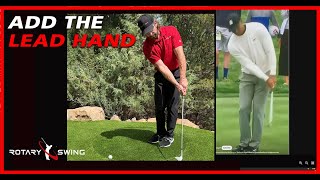











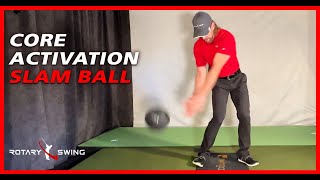





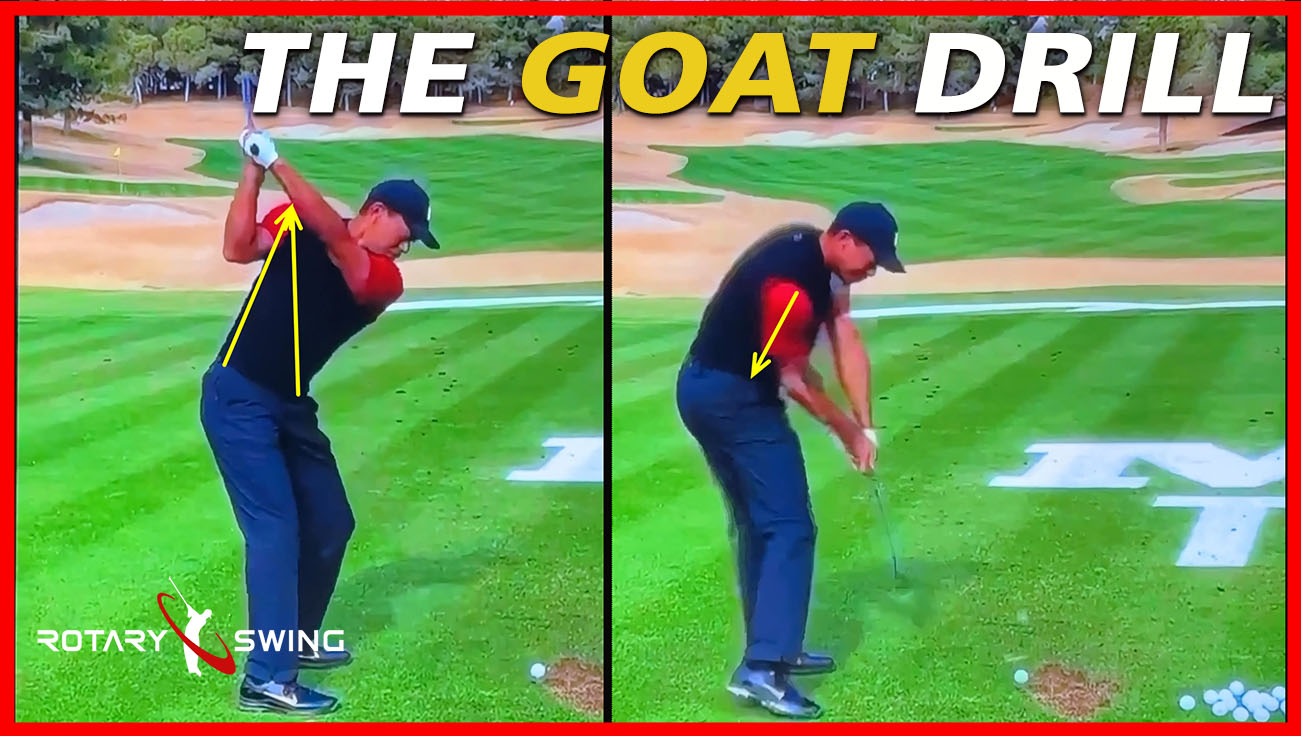


















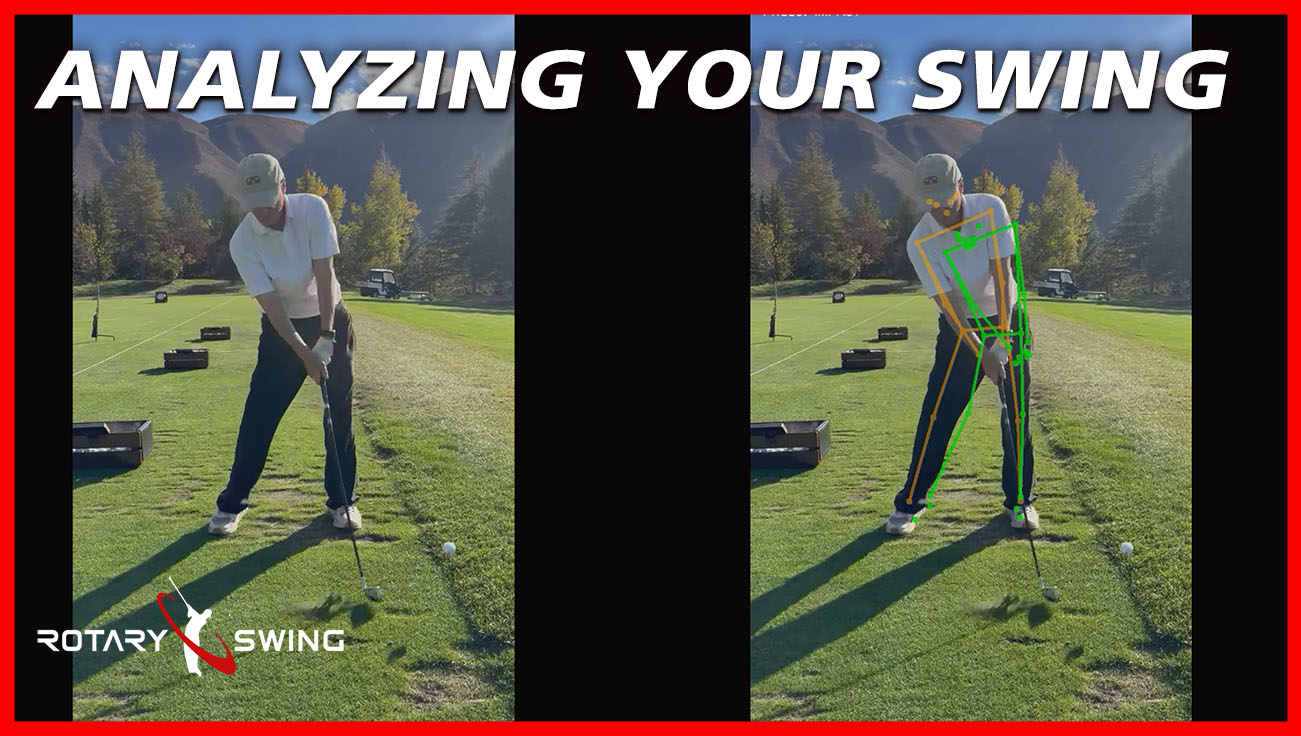










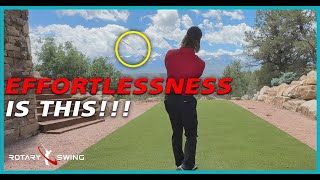
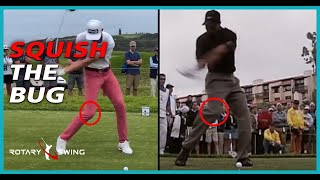











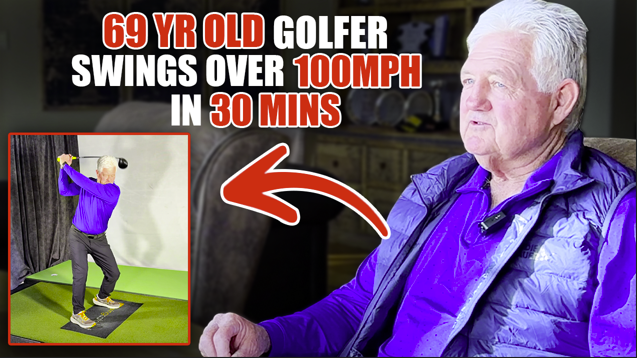

















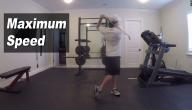

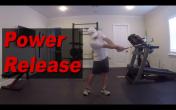

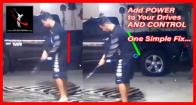
















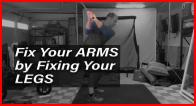










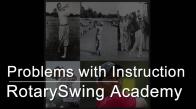




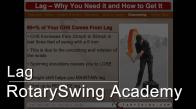



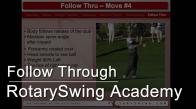















































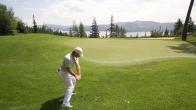















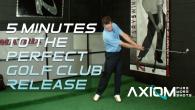



 "Namaste" position
"Namaste" position Engage the obliques to perform proper upper body golf rotation
Engage the obliques to perform proper upper body golf rotation Are you pushing with your left hand?
Are you pushing with your left hand? Shoulder rotation, as seen from above
Shoulder rotation, as seen from above Let your torso transport your arms
Let your torso transport your arms Don't let your hands get ahead of your chest
Don't let your hands get ahead of your chest Repeat the drill in setup posture
Repeat the drill in setup posture Leave your hands at address
Leave your hands at address Add the club back in
Add the club back in
